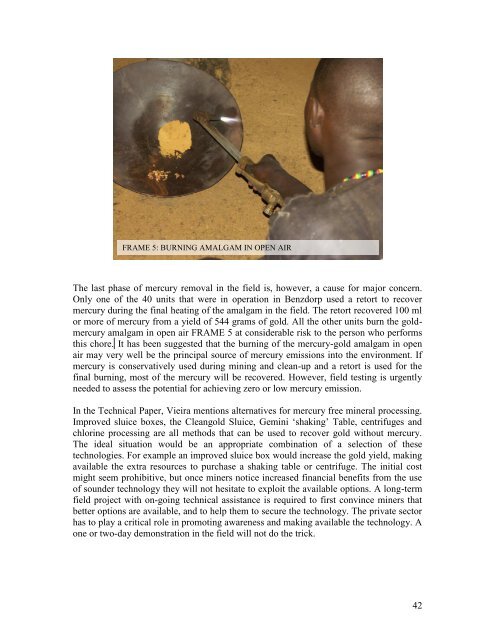SITUATION ANALYSIS OF THE SMALL-SCALE GOLD ... - WWF
SITUATION ANALYSIS OF THE SMALL-SCALE GOLD ... - WWF
SITUATION ANALYSIS OF THE SMALL-SCALE GOLD ... - WWF
You also want an ePaper? Increase the reach of your titles
YUMPU automatically turns print PDFs into web optimized ePapers that Google loves.
FRAME 5: BURNING AMALGAM IN OPEN AIR<br />
The last phase of mercury removal in the field is, however, a cause for major concern.<br />
Only one of the 40 units that were in operation in Benzdorp used a retort to recover<br />
mercury during the final heating of the amalgam in the field. The retort recovered 100 ml<br />
or more of mercury from a yield of 544 grams of gold. All the other units burn the goldmercury<br />
amalgam in open air FRAME 5 at considerable risk to the person who performs<br />
this chore. It has been suggested that the burning of the mercury-gold amalgam in open<br />
air may very well be the principal source of mercury emissions into the environment. If<br />
mercury is conservatively used during mining and clean-up and a retort is used for the<br />
final burning, most of the mercury will be recovered. However, field testing is urgently<br />
needed to assess the potential for achieving zero or low mercury emission.<br />
In the Technical Paper, Vieira mentions alternatives for mercury free mineral processing.<br />
Improved sluice boxes, the Cleangold Sluice, Gemini „shaking‟ Table, centrifuges and<br />
chlorine processing are all methods that can be used to recover gold without mercury.<br />
The ideal situation would be an appropriate combination of a selection of these<br />
technologies. For example an improved sluice box would increase the gold yield, making<br />
available the extra resources to purchase a shaking table or centrifuge. The initial cost<br />
might seem prohibitive, but once miners notice increased financial benefits from the use<br />
of sounder technology they will not hesitate to exploit the available options. A long-term<br />
field project with on-going technical assistance is required to first convince miners that<br />
better options are available, and to help them to secure the technology. The private sector<br />
has to play a critical role in promoting awareness and making available the technology. A<br />
one or two-day demonstration in the field will not do the trick.<br />
42
















